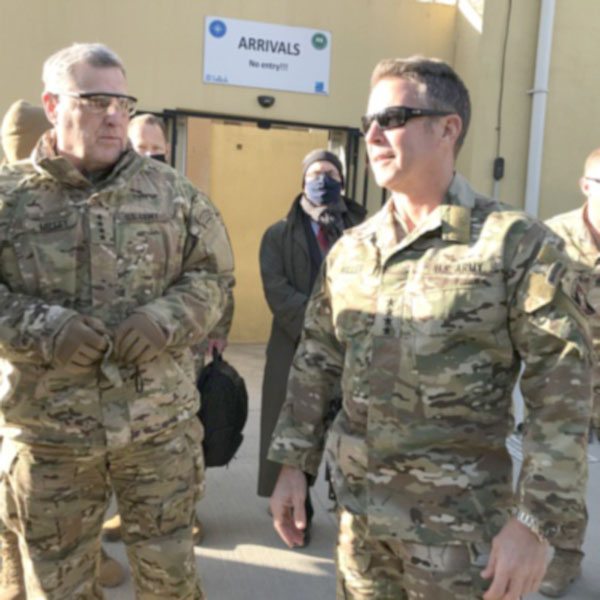The Joint Chiefs chairman’s meeting comes at a profound moment of uncertainty for the U.S.-brokered talks on Afghanistan
By Katie Bo Williams
Joint Chiefs Chairman Gen. Mark Milley this week met with Taliban negotiators in Doha, Qatar, amid an ongoing U.S. troop drawdown from Afghanistan and rising violence in the southern parts of the country. The two and a half-hour meeting was the second time Milley has met with the Taliban as part of U.S. efforts to bring about a negotiated peace settlement between the insurgent group and the U.S.-recognized government in Kabul.
He is the first known chairman of the Joint Chiefs to have met with the Taliban, which the United States has been fighting either directly or in support of Afghan security forces since shortly after the Sept. 11 attacks in 2001. Milley also met Wednesday with Afghan President Ashraf Ghani, in Kabul, as part of a four-day swing through the region that comes just weeks before a new administration takes office. For operational security reasons, Defense One agreed not to disclose the meeting until Milley was out of the region, at the request of defense officials.
“The most important part of the discussions I had with both the Taliban and the government of Afghanistan was the need for a reduction in violence,” Milley told defense reporters traveling with him. “Everything else hinges on that.” U.S. negotiators have been urging both sides to move forward towards a genuine, nation-wide ceasefire in the next 30 to 40 days, said a person familiar with the negotiations. On Jan. 20, President-elect Joe Biden will take office. Biden has publicly called for a small, nimble counter terrorism force to remain in Afghanistan; how his administration will handle the fragile peace negotiations remains unknown.
Among the conditions laid out in the initial U.S.-Taliban deal paving the way for both the American drawdown and the negotiated settlement with the Afghan government, inked in February, was a provision calling for a steep reduction in violence leading to a nation-wide ceasefire. Although the Taliban has not attacked U.S. or coalition forces since that deal was signed, it has continued to mount devastating attacks against Afghan government forces.
October marked the highest civilian death toll in a single month since September 2019, according to a running report from the New York Times. In some southern provinces that are historic strongholds for the group, the Taliban this fall has ramped up the deliberate destruction of public infrastructure, stymying troop reinforcements for the government forces and cutting off the region’s civilians from the rest of the country.
Broadly, the war has been fought to a protracted stalemate that American military officials say cannot be won or lost on the battlefield. “We saw what we would term ‘out of the ordinary’ offenses in Helmand Province and Kandahar Province,” Gen. Scott Miller, the head of U.S. forces in Afghanistan, said Wednesday in Kabul. “My assessment is it puts the peace process at risk. The higher the violence, the higher the risk.”
The U.S. drawdown continues on schedule, Miller and Milley said, with about 4,000 U.S. troops currently in Afghanistan. President Donald Trump in November ordered an accelerated withdrawal of U.S. troops, down to 2,500, before Biden takes office. Some critics have argued that the withdrawal announcement has divorced the American withdrawal of the conditions laid out in the February agreement, rewarding the Taliban despite ongoing attacks. Others have insisted it needlessly puts the remaining American troops at risk.
Miller and Milley insisted that 2,500 troops is sufficient to protect the force and its Afghan partners, as well as carry out their mission of preventing another 9/11-style attack on the United States. Miller provided a handful of new details about how the remaining 2,500 troops will be structured. “In some cases what we’ve done is we’ve shrunk the size of [U.S. bases], so we’ve built enclaves instead of trying to maintain an entire base,” he said.
The United States will still be able to train, advise and assist the Afghan security forces at the ministerial level and down to the corps level in the northern parts of the country if not the bloodier southern provinces and will retain “the ability to project to what we refer to as ‘points of need,’ which are lower than the corps level,” Miller said.
“What we do is call in a flight to advise and just move a package,” he said of the lighter footprint, expeditionary advisory efforts. “It’s a flight with the appropriate security to advise forces. You have the ability if you have a place that you must go, to be able to do that.” Some infrastructure and equipment that the United States has built up over two decades of war in Afghanistan will need to be destroyed as it downsizes, Miller and Milley said, while some will be transferred to the Afghans and some will return to Defense Department inventory.
“It’s more efficient and cost-effective to just destroy it,” Milley said. Milley first met with the Taliban in June, in support of the primary U.S. negotiating team led by Amb. Zalmay Khalilzad. The Taliban at that point was refusing to negotiate directly with the Afghan government, which it has long considered a puppet of the United States. That meeting, which began at 8:30 p.m. and stretched into the wee hours of the morning, led to a breakthrough that paved the way for direct negotiations between Ghani’s government and the Taliban.
Milley pushed both sides to “embrace peace,” according to the person familiar with the talks, by quickly beginning intra-Afghan talks and compromising on the thorny issue of a prisoner exchange. Shortly after that meeting with the Taliban, which has not previously been revealed, the group announced a ceasefire for the Islamic holiday of Eid. The first direct talks between the two sides began in September.
The fate of the delicate negotiations, as well as the long-term U.S. presence in Afghanistan, remains a subject of intense speculation as Biden prepares to take office. Trump, in part propelled by a national mood of weariness with the 20-year conflict, has sought in fits and starts to end American involvement there. The process has often been defined by contradictory statements from public officials, abrupt tweets from the president, and criticism by even the president’s staunchest allies.
But in practical terms, the course Biden has laid out publicly is not dramatically different from the force posture he will inherit: a small counterterrorism – focused force able to respond to any threats to the United States or its interests. Whether he will stick to the long-term plan the Trump administration laid out in the February agreement remains to be seen.
The February deal envisions a complete drawdown of U.S. forces by May 2021 if the Taliban meets certain conditions, including reducing the violence and renouncing al Qaeda, which it has not yet done. The Taliban have threatened to resume attacks on U.S. and coalition forces if Biden doesn’t stick to the May timeline.
Milley may be one of the few high-ranking officials to represent continuity between the Trump administration and the Biden administration’s handling of the negotiations, although it is possible Biden will keep Khalilzad at the head of the effort. Despite arguments from both the left and the right that the war is no longer necessary to keep Americans safe from terror attacks, Milley believes that there is a persistent national interest in keeping U.S. troops in Afghanistan to prevent another 9/11-style attack.
Whatever Biden decides about either the U.S. withdrawal or the American sponsorship of the talks, U.S. officials say any kind of reconciliation or power-sharing agreement between the Afghan government and the Taliban is impossible if the Taliban do not curtail their violent attacks. Many also believe that if the United States were to withdraw all of its support, the government in Kabul would quickly collapse.
“The level of violence makes it extremely difficult for any Afghan leaders to go very far down the road in these peace talks,” Amb. Ross Wilson, the U.S. chargé d’affairs in Afghanistan. “It’s an unbearable burden on the Afghan forces, it’s an unbearable burden for Afghan society including the range of attacks in urban areas, assassinations, kidnappings, market bombings, other activities like that,” he said Wednesday. “Not all of which may be Taliban, but the cumulative affect of that high level of loss is unraveling the situation.”







